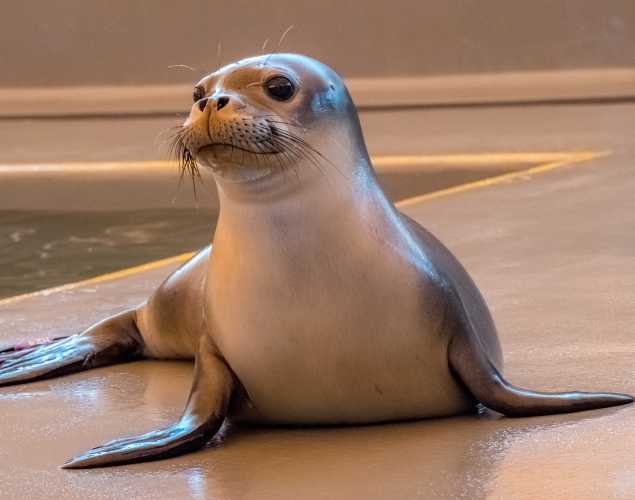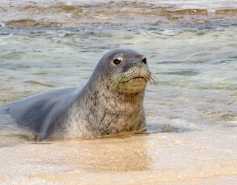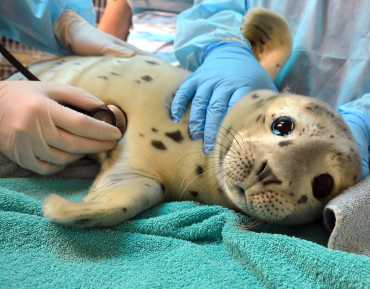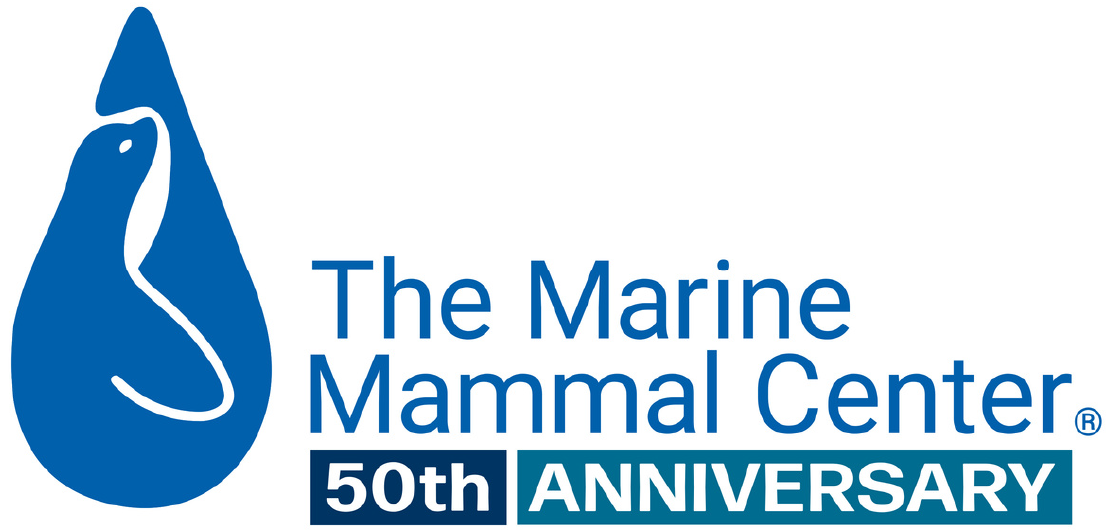
Ke Kai Ola Admits First Adult Monk Seal
- Malnutrition
- Species conservation
Four endangered Hawaiian monk seals—a five-year-old, a yearling and two pups—are currently being treated at our hospital in Hawaii.
Four endangered Hawaiian monk seals were recently transported by NOAA researchers from the Northwestern Hawaiian Islands and brought to The Marine Mammal Center’s monk seal hospital, Ke Kai Ola, where they will receive rehabilitative care.
“These iconic animals are getting a second chance at life thanks to our ongoing partnership with NOAA as well as our community of supporters and volunteers,” says Dr. Shawn Johnson, Director of Veterinary Science at The Marine Mammal Center.
Every step of the way—from the moment they were rescued by NOAA researchers on a remote beach to their time at Ke Kai Ola to their release back to the wild—these Hawaiian monk seals will receive the best medical support available.
Admitted primarily due to malnourishment, all four seals are showing signs of progress since their arrival at the end of August. Two of the new patients are pups that were weaned too early, one is a yearling and the fourth is an extremely underweight five-year-old, the oldest monk seal patient at Ke Kai Ola to date.
Meet Our Current Patients:
- Niho`ole – a male pup whose name means “toothless” because he had no teeth when NOAA researchers first spotted him
- Lele-aka – a female pup whose name means “milky way”
- Ha`aheo – a female yearling whose name means “shy with pride”
- Mea Ola – a five-year-old female whose name means “survivor”
Although five-year-old Mea Ola is older than any of our previous patients at Ke Kai Ola, she was much smaller and thinner than others in her age group. Researchers noted that she had been declining in condition over the past two seasons and appeared to decline even more rapidly this season, resulting in a decision to bring her to Ke Kai Ola for care.
Learn More About Hawaiian Monk Seals
Sign up to receive Hawaiian monk seal news, patient updates and more straight to your inbox.
{"image":"\/Animals\/Wild\/Hawaiian monk seal\/hawaiian-monk-seal-shutterstock.jpg","alt":"Hawaiian monk seal at the shoreline","label":"Pinnipeds","title":"Hawaiian Monk Seal","link_url":"\/animal-care\/learn-about-marine-mammals\/pinnipeds\/hawaiian-monk-seal","type":"page"}

{"image":"\/Animals\/Wild\/Hawaiian monk seal\/cropped-images\/HMS-wild-NOAA-4-832-3197-1474-1603733454.jpg","alt":"Two Hawaiian monk seals sleeping on the beach.","label":"Conservation","title":"Hawaiian Monk Seal Conservation","link_url":"\/science-conservation\/conservation\/hawaiian-monk-seal-conservation","type":"page"}

{"image":"\/Animals\/Patients\/Hawaiian monk seals\/2015\/hms-pearl-by-julie-steelman-c-the-marine-mammal-center-noaa-permit-18786.jpg","alt":"Hawaiian monk seal Pearl","title":"Understanding Endangered","link_url":"https:\/\/www.marinemammalcenter.org\/publications\/understanding-endangered","label":"Online Learning Resource","type":"publication"}

{"image":"\/Animals\/Patients\/Hawaiian monk seals\/2016\/hms-nihoole-5-photo-c-noaa-permit-16632.jpg","alt":"Hawaiian monk seal Niho'ole","title":"Aloha \u02bb\u0100ina","link_url":"https:\/\/www.marinemammalcenter.org\/publications\/aloha-aina","label":"Online Learning Resource","type":"publication"}

There are currently only about 1,300 Hawaiian monk seals, a population that has been shrinking in recent decades. NOAA researchers that have been tracking this population recently returned from a four-month long mission to the Northwestern Hawaiian Islands, where at least 159 pups were born this year.
That is slightly more than were born in 2015—part of a four-year trend of moderate increases. While this is positive news for the population, many more years of progress are needed before the population is out of danger.
Young seals are the most vulnerable animals in the population with relatively few surviving to adulthood. Pups and juvenile seals in the Northwestern Hawaiian Islands often fall victim to threats like entanglement in ocean trash, changes in the food chain and predation.
According to a new NOAA report, endangered Hawaiian monk seals are also highly sensitive to climate change impacts. Sea-level rise and increased coastal erosion will reduce the haul-out sites they depend on, and may increase shark predation. Increasing sea surface temperatures will limit available prey for marine mammals just as it has on the West Coast of the United States.
The four monk seals in our care right now are likely to stay at our facility in Kona for at least a few months while they gain strength before returning to the Northwestern Hawaiian Islands where they were rescued.
Volunteer Opportunities on Hawaiʻi and Maui
Hawaiian monk seal conservation volunteers play an integral role in helping save this endangered species by monitoring and identifying seals that may require rescue and rehabilitation.
Volunteers also provide valuable public outreach to help raise awareness about the risks of human and pet interactions, and why this native animal is critical to the health of our shared ocean home.
The Center values volunteer engagement and inclusivity, and is proud to welcome existing and new volunteers into its ohana, or family, to create an even more robust and diverse community of volunteers.
Since opening the hospital two years ago, The Marine Mammal Center's veterinary experts have successfully rehabilitated more than 1 percent of the population, returning 15 healthy monk seals back to the wild. As these seals mature and have pups of their own in five years or so, monk seal experts hope this will improve the species’ chances of survival in the islands that have been their home for millions of years.
The Marine Mammal Center's team also monitors Hawaiian monk seal haul out activity on the island of Hawaii and manages rescue efforts for sick and injured seals reported to the hospital’s hotline (808-987-0765).
You Can Be a Hawaiian Monk Seal Hero
Thanks to our generous donors, Hawaiian monk seal pups like Mea Ola are able to get a second chance at life in the wild. You can make a real difference for this endangered species and all of the marine mammals in our care by making a life-saving gift today.
Header image: photo by Julie Steelman © The Marine Mammal Center / NOAA permit #18786
Yes, I want to save a life!

Yes, I want to save a life!
You’ll be giving sick and injured animals the best possible care at the Center’s state-of-the-art hospital. With your gift today, you are giving a patient a second chance at life in the wild.
See Our Latest News
{"image":"\/Animals\/Patients\/Harbor seals\/2020\/cropped-images\/hs-barnwood-by-bill-hunnewell-c-the-marine-mammal-center-315-0-3299-2577-1607370547.jpg","alt":"harbor seal Barnwood","title":"Last-Minute Gift Guide \u2013 Top Gifts that Give Back to Marine Animals","link_url":"https:\/\/www.marinemammalcenter.org\/news\/last-minute-gift-guide","label":"News Update","date":"2025-12-18 01:00:00"}

Last-Minute Gift Guide – Top Gifts that Give Back to Marine Animals
December 18, 2025
Read More{"image":"\/Animals\/Patients\/Hawaiian monk seals\/2025\/cropped-images\/b-ru72admission-to-ke-kai-ola112125photo-c-the-marine-mammal-center-noaa-permit-24359-0-364-1270-992-1766095407.jpg","alt":"A newborn Hawaiian monk seal pup with a black coat in rehabilitative care.","title":"Newborn Hawaiian Monk Seal Pup Now Receiving Care","link_url":"https:\/\/www.marinemammalcenter.org\/news\/newborn-hawaiian-monk-seal-pup-now-receiving-care","label":"Patient Update","date":"2025-12-18 01:00:00"}

{"image":"\/Animals\/Patients\/Hawaiian monk seals\/2025\/cropped-images\/d-ru28release-exam-at-ke-kai-ola111025photo-by-giancarlo-rulli-c-the-marine-mammal-center-noaa-permit-24359-0-0-1270-992-1764620886.jpg","alt":"","title":"Bird Flu Vaccine Trial Offers Hope for Protecting Hawaiian Monk Seals","link_url":"https:\/\/www.marinemammalcenter.org\/news\/bird-flu-vaccine-trial-may-offer-hope-for-protecting-hawaiian-monk-seals","label":"News Update","date":"2025-12-01 08:13:00"}

Bird Flu Vaccine Trial Offers Hope for Protecting Hawaiian Monk Seals
December 1, 2025
Read More{"image":"\/Animals\/Patients\/Hawaiian monk seals\/2021\/hms-pp08-by-sheila-latta-c-the-marine-mammal-center-noaa-permit-18786.jpg","alt":"Hawaiian monk seal","title":"The New York Times: Inside the Bird-Flu Vaccine Trial for Monk Seals","link_url":"https:\/\/www.marinemammalcenter.org\/news\/the-new-york-times-inside-the-bird-flu-vaccine-trial-for-monk-seals","label":"In the News","date":"2025-12-01 01:00:00"}

The New York Times: Inside the Bird-Flu Vaccine Trial for Monk Seals
December 1, 2025
Read More